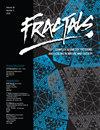磁化电子-正电子等离子体中弱非线性分数离子声波精细动力学研究
IF 2.9
3区 数学
Q1 MATHEMATICS, INTERDISCIPLINARY APPLICATIONS
Fractals-Complex Geometry Patterns and Scaling in Nature and Society
Pub Date : 2023-10-19
DOI:10.1142/s0218348x23401977
引用次数: 0
摘要
本文采用三种先进的计算和数值方法求解磁化等离子体中的非线性分数阶修正Korteweg-de Vries-Zakharov-Kuznetsov (mKdV-ZK)方程。利用约化微扰方法研究了磁化等离子体中各种组分的动力学,即等温物质、不动背景物质和热绝热流体。重点讨论了非线性静电波的不对称传播特性。该模型的解决方案包含不同类型的孤子,包括离子声学、尘埃声学和电子声学孤子。解析解是用各种数学函数得到的,比如指数、三角函数和双曲线。二维和三维密度图说明了单个孤子的实际行为。采用数值格式的主要目的是评估导出解的准确性,结果证明了解析方法在解决非线性数学和物理问题方面的有效性。采用多种技术验证计算结果与估计结果的一致性,保证了研究的准确性和可靠性。总的来说,这项研究强调了数值和分析技术在解决复杂数学模型方面的有效性,为该领域的未来研究提供了一条有希望的途径。这些发现对理解磁化等离子体中的非线性现象具有重要意义,并有助于该领域的发展。本文章由计算机程序翻译,如有差异,请以英文原文为准。
Investigation of the Elaborate Dynamics of Weakly Nonlinear Fractional Ion-Acoustic Waves in Magnetized Electron-Positron Plasma
This study employs three advanced computational and numerical techniques to solve the nonlinear fractional modified Korteweg–de Vries–Zakharov–Kuznetsov (mKdV–ZK) equation in magnetized plasma. The reductive perturbation approach is utilized to investigate the dynamics of various components, namely isothermal species, immobile background species, and warm adiabatic fluid, in magnetized plasma. Emphasis is placed on unraveling the asymmetrical propagation characteristics of nonlinear electrostatic waves. The model’s solutions encompass diverse types of solitons, including ion-acoustic, dust acoustic, and electron acoustic solitons. Analytical solutions are obtained using a variety of mathematical functions, such as exponents, trigonometry, and hyperbolas. Two- and three-dimensional density graphs illustrate the practical behavior of a single soliton. The primary objective of employing numerical schemes is to assess the accuracy of the derived solutions, and the outcomes demonstrate the efficacy of the analytical method in solving nonlinear mathematical and physical problems. Several techniques are employed to validate the consistency between calculated and estimated results, ensuring the study’s accuracy and reliability. Overall, this investigation underscores the effectiveness of numerical and analytical techniques in tackling complex mathematical models, offering a promising avenue for future research in the field. The findings carry significant implications for comprehending nonlinear phenomena in magnetized plasma and contribute to advancing the field.
求助全文
通过发布文献求助,成功后即可免费获取论文全文。
去求助
来源期刊
CiteScore
7.40
自引率
23.40%
发文量
319
审稿时长
>12 weeks
期刊介绍:
The investigation of phenomena involving complex geometry, patterns and scaling has gone through a spectacular development and applications in the past decades. For this relatively short time, geometrical and/or temporal scaling have been shown to represent the common aspects of many processes occurring in an unusually diverse range of fields including physics, mathematics, biology, chemistry, economics, engineering and technology, and human behavior. As a rule, the complex nature of a phenomenon is manifested in the underlying intricate geometry which in most of the cases can be described in terms of objects with non-integer (fractal) dimension. In other cases, the distribution of events in time or various other quantities show specific scaling behavior, thus providing a better understanding of the relevant factors determining the given processes.
Using fractal geometry and scaling as a language in the related theoretical, numerical and experimental investigations, it has been possible to get a deeper insight into previously intractable problems. Among many others, a better understanding of growth phenomena, turbulence, iterative functions, colloidal aggregation, biological pattern formation, stock markets and inhomogeneous materials has emerged through the application of such concepts as scale invariance, self-affinity and multifractality.
The main challenge of the journal devoted exclusively to the above kinds of phenomena lies in its interdisciplinary nature; it is our commitment to bring together the most recent developments in these fields so that a fruitful interaction of various approaches and scientific views on complex spatial and temporal behaviors in both nature and society could take place.

 求助内容:
求助内容: 应助结果提醒方式:
应助结果提醒方式:


